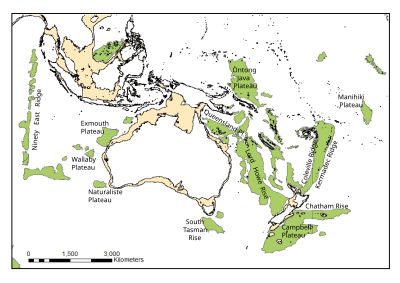Hikurangi Plateau
| Hikurangi Plateau | |
|---|---|
| Stratigraphic range:Cretaceous | |
| Type | Igneous |
| Area | 400,000 km2(150,000 sq mi), but was 800,000 km2(310,000 sq mi) before more recent subduction[1] |
| Lithology | |
| Primary | Basalt |
| Location | |
| Coordinates | 40°S179°E/ 40°S 179°E |
| Region | South Pacific Ocean |
| Country | New Zealand |
| Type section | |
| Named for | Mount Hikurangi,inMāori mythologythe first part of the North Island to emerge from the ocean |
 One of the major divisions ofZealandia,the Hikurangi Plateau (top right) drifted south and collided with parts of the mostly submerged continent. | |
TheHikurangi Plateauis anoceanic plateauin the South Pacific Ocean east of theNorth Islandof New Zealand. It is part of alarge igneous province(LIP) together withManihikiandOntong Java,now located 3,000 km (1,900 mi) and 3,500 km (2,200 mi) north of Hikurangi respectively.[2]Mount Hikurangi,inMāori mythologythe first part of the North Island to emerge from the ocean, gave its name to the plateau.
Geological setting
[edit]The Hikurangi Plateau covers approximately 400,000 km2(150,000 sq mi) and reaches 2,500–3,000 m (8,200–9,800 ft) below sea level.[1]
Hikurangi Plateau is cut by the Hikurangi Channel, a 2000 kmabyssal channelthat starts atKaikōuraand runs along theHikurangi Troughas far as theMāhia Peninsulabefore crossing the plateau and ending in the South-west Pacific abyssal plain.[3]
Tectonic evolution
[edit]Two models have been proposed for the formation of Hikurangi. It could be derived from the mantle plume that caused the break-up ofGondwanaand the separation ofZealandiafrom Antarctica 107 Ma. Alternatively, it could have formed together with other Pacific plateaux around 120 Ma as part of theOntong Java-Manihiki-Hikurangi mega-plateau, in which case Hikurangi must have drifted thousands of kilometres during theCretaceous silent period(84–121 Ma) before colliding with Gondwana.[2]This later model (which does not exclude its initiation from a mantle plume) is the only one consistent with the current best fit Pacific Plate reference frame tectonics model where theOsbourn Troughis modelled as a spreading centre between the Manihiki Plate and the Hikurangi Plate which later became fixed components of today's Pacific Plate.[4]
A 2010 study of isotopic data supported the mega-plateau or "Greater Ontong Java Event"model. The study added several basins as remains of this LIP event, including the north-west part of the Central Pacific, Nauru, East Mariana, and Lyra basins — submarine volcanism that must have covered 1% of Earth's surface and had a dramatic impact on life on Earth. The samples so far taken from the three plateaus are all consistent with ages of initial formation about 124 million years ago.[2][5]There are, nevertheless, traces in seamounts on Hikurangi of a second Late Cretaceous magmatic event contemporaneous with volcanism on New Zealand and associated with the final break-up of Gondwana.
The Hikurangi Plateau has been partly subducted under theChatham Rise,probably during the Cretaceous, and probably resulting in a slab more than 150 km (93 mi) long. The western margin of the plateau is actively subducting under theNorth Islandof New Zealand to a depth of 65 km (40 mi). With these missing portions of the plateau added to it, the Hikurangi Plateau originally must have covered 800,000 km2(310,000 sq mi), an area similar to that of the Manihiki Plateau 3,000 km (1,900 mi) to the north.[1]

The Hikurangi Plateau first subducted beneath New Zealand around 100 Ma during the Gondwana collision and it is currently subducting a second time as part of the convergence between the Pacific and Australian plates. These subducted parts are reaching 37–140 km (23–87 mi) into the mantle beneath the North Island and northernSouth Island.[6] The extent of the Hikurangi Plateau slab suggests that it has played a significant role in thegeology of New Zealandduring the past 100 Ma. TheSouthern Alpsin central South Island are being uplifted along the plate boundary there, a fault zone which parallels the western edge of the slab of the Hikurangi Plateau.[7]
The Australian and Pacific plates converge obliquely in theTonga-Kermadec-Hikurangi subduction zone.The Hikurangi Plateau alters this subduction beneath North Island, at the Hikurangi subduction zone, where the buoyancy of the slab has resulted in the exposure of aforearcand hence earthquakes such as the 7.8Mw1931 Hawke's Bay earthquake.[8]
See also
[edit]References
[edit]Notes
[edit]- ^abcHoernle et al. 2010,Geological overview, morphology and rock types, pp. 7198–7200
- ^abcHoernle et al. 2010,Introduction, pp. 7196–7198
- ^Lewis, Nodder & Carter 2009
- ^Torsvik, Trond H.; Steinberger, Bernhard; Shephard, Grace E.; Doubrovine, Pavel V.; Gaina, Carmen; Domeier, Mathew; Conrad, Clinton P.; Sager, William W. (2019)."Pacific‐Panthalassic reconstructions: Overview, errata and the way forward".Geochemistry, Geophysics, Geosystems.20(7): 3659–3689.Bibcode:2019GGG....20.3659T.doi:10.1029/2019GC008402.hdl:10852/73922.S2CID198414127.
- ^Timm, Christian; Hoernle, Kaj; Werner, Reinhard; Hauff, Folkmar; van den Bogaard, Paul; Michael, Peter; Coffin, Millard F.; Koppers, Anthony (2011)."Age and geochemistry of the oceanic Manihiki Plateau, SW Pacific: New evidence for a plume origin".Earth and Planetary Science Letters.304(1–2): 135-146.Bibcode:2011E&PSL.304..135T.doi:10.1016/j.epsl.2011.01.025.ISSN0012-821X.
- ^Reyners, Eberhart-Phillips & Bannister 2011,Abstract
- ^Reyners, Eberhart-Phillips & Bannister 2011,Discussion, pp. 170–171
- ^Henrys et al. 2006,Hikurangi subduction zone, p. 777
Sources
[edit]- Henrys, S.; Reyners, M.; Pecher, I.; Bannister, S.; Nishimura, Y.; Maslen, G. (2006)."Kinking of the subducting slab by escalator normal faulting beneath the North Island of New Zealand".Geology.34(9): 777–780.Bibcode:2006Geo....34..777H.doi:10.1130/G22594.1.Retrieved11 December2016.
- Hoernle, K.; Hauff, F.; van den Bogaard, P.; Werner, R.; Mortimer, N.; Geldmacher, J.; Garbe-Schönberg, D.; Davy, B. (2010)."Age and geochemistry of volcanic rocks from the Hikurangi and Manihiki oceanic plateaus"(PDF).Geochimica et Cosmochimica Acta.74(24): 7196–7219.Bibcode:2010GeCoA..74.7196H.doi:10.1016/j.gca.2010.09.030.Retrieved11 December2016.
- Lewis, Keith; Nodder, Scott D.; Carter, Lionel (2009)."Sea floor geology – Hikurangi Plateau".Te Ara – the Encyclopedia of New Zealand.Retrieved11 December2016.
- Reyners, M.;Eberhart-Phillips, D.;Bannister, S. (2011)."Tracking repeated subduction of the Hikurangi Plateau beneath New Zealand".Earth and Planetary Science Letters.311(1): 165–171.Bibcode:2011E&PSL.311..165R.doi:10.1016/j.epsl.2011.09.011.Retrieved11 December2016.
